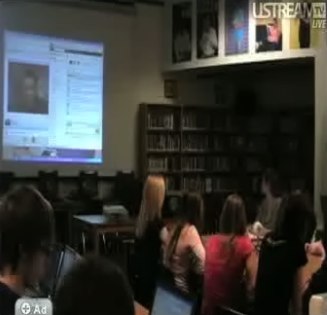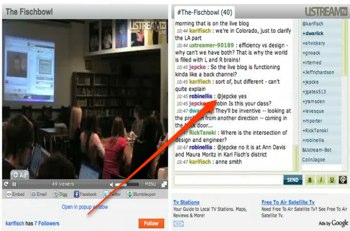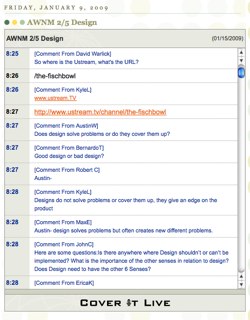If you haven’t read part 1 yet, then click on back and give it a scan. If you’ve already read it, then you are ready for part 2 — the really good part.
A while back, Karl Fisch (of Did you Know fame), an educator in suburban Denver Colorado, sent out an invitation to a number of education bloggers to come and sit in on a project he was conducting at his high school — a discussion with Daniel Pink. Here is how it worked:
 Daniel Pink broadcasted his presence into the school’s library using Ustream. There students, who had already read A Whole New Mind, ask Pink questions about the book. Yesterday’s conversations were about design, one of the six aptitudes described in the book.
Daniel Pink broadcasted his presence into the school’s library using Ustream. There students, who had already read A Whole New Mind, ask Pink questions about the book. Yesterday’s conversations were about design, one of the six aptitudes described in the book.
Ustream offers a chat panel, so many of the outsiders who were watching from afar used this chat feature to post comments and to hold conversations in plain view of the students.
The teacher, Ms. Smith, also set up a blog for the event and installed ConverItLive on a blog post dedicated for the day. The students, as they were paying attention, engaged in interviewing Dan, and monitoring the chat on Ustream, posted their insights on ConverItLive.
I mistakenly thought that that’s where the invited bloggers were supposed to be, so my comments were posted there.
Now, up front, this is almost too many channels. It is too much to monitor and react to. So I picked the channels that suited me best (audio and video of the interviews) and responded through CoverItLive. The rest slipped past me. But that’s OK.
 |
|
|
You see, what’s new, and cool, and so much in the spirit of 2.0 about this experience is that it is about conversation, and about conversation being turned into content. It was easy to record Dan’s answers and the audio (and video) of the students’ questions. But to have the students (and visitors) engaged in a parrellel, even subterranian conversation about what’s happening in the open air and to have that conversation available for later reference and work, seems extremely powerful to me.
 |
|
|
Students are not being taught. They aren’t learning to be taught. They are learning to listen and respond, to sythesize and to share, read, work, and reword.
It seems to me that a clever follow-up activity might be to have the students each work up a concept map of the interview, and then pick out comments made by students and visitors related to each element of the map, assembling it all into a logical and valuable information product (report, slide deck, presentation, web site, etc.)
Anyway, you can see the videos of the sessions at Karl’s Ustream channel, The-Fischbowl. Just scroll about 2/3 down the page and click out the video clips. You can also read the students’ CoverItLive transcrip at Ms. Smith’s blog page. Of special interest are the comments posted later by the students.
It strikes me that this activity represents a lot of what many of us have been talking about with Learning 2.0. The walls of that library were transparent yesterday. Students were connected, engaged, working, and producing. I’ll likely be talking about this some more.
Powered by ScribeFire.

I can’t agree more with what you have said here. “Students are not being taught. They aren’t learning to be taught. They are learning to listen and respond, to sythesize and to share, read, work, and reword.”
This is so powerful. Recently, my students have begun a blogging adventure. Far more quickly than I had anticipated, their writing improved. Not only was it structurally sound, but it was well-supported. They respond to one another with praise and trust. These students teach themselves.
Your comments are very valid to me. My students in the tenth grade have recently begun a blogging adventure. Far more quickly than I had anticipated, their writing improved. The writing presented was both structurally sound and well-supported. Their responses to one another were also supported and full of praise. I see these tools as completely beneficial to the learning process. You’re right students are not being taught… they are learning without even thinking about it.
Hello Mr. Warlick,
I am a sophomore at Indiana Wesleyan University and taking a Digital Media Production course. The professor encouraged us to search through blogs to find one that attracted you and then ask the author for an interview. I was wondering if it was at all possible for you to please contact me at alex.canfield@student.indwes.edu so I could ask you a few questions. Thank you for your time, I look forward to hearing from you.
Alex Canfield
More and more I am seeing this shift toward a “publish then filter” model. What this means is that we have to develop seamlessly easy methods for gathering in digital data, publishing data, and then figuring out ways to dip the cup into that data for discrete drinks. Tagging the data will be especially difficult especially in “river”-type audio and video feeds. Gather, filter, publish/produce: our new mantra. It seems to me that we are redefining what self-reflection means, too. Now we need to dip that cup into our own lifestream and we need to show our students how to do this as well.
Wow, being part of this “experiment” coming from a student’s perspective the process really does work. It’s more of instead of the teacher teaching us, the students teach themselves. It’s actually my favorite class, and I recommend that LA teachers take this learning style into consideration. I think why it works is that students are a lot more than given credit for, even kids in general. We can teach ourselves effectively and go far with our learning. Anyways the Daniel Pink conversation was an amazing experience to go through, and he is a very wise person in his writings. It’s very hard to disagree with what he says. Well this experience was unlike any other and i can only hope i will get another chance like this.
Thank you for joining us when we blogged with Daniel Pink. You input was very much appreciated. Hopefully you will join us again. I would have to say that you were right when you said, “Students are not being taught. They aren’t learning to be taught. They are learning to listen and respond, to synthesize and to share, read, work, and reword.” in Smith’s class we are learning in this way.
Thank you so much for blogging and participating with us. I was in the inner circle and talking with Dan Pink was such an honor, I was trying to really understand the level of intellect that Dan Pink comes from. It is great that you really believe that we are not just learning but we are creating, producing, responding, and working hard to really try to grasp the concepts and try to change the world, becuase slowly, we are. Thank you for writing such amazing feedback and we hope to blog with you again soon.
A student from Smith’s period 2 class,
Laura O.
Mr. Warlick-
Thank you for taking the time to listen in and add tremendously to our fishbowl discussion with Daniel Pink. It was a new expeience for many of us, introducing the world to our previously closed and personal discussion. It was unreal to have so many people around the world feeling so much interest in a conversation being led by a group of ninth graders. You had so much good feedback, and we all benefited greatly. It feels great to be recognized on a global level for having strong thoughts and discussions. Thank you aain for the praise and feedback you offered.
Katie
Hello. I am from Ms. Smith’s 9th grade English honors class. I participated in the fishbowl with Daniel Pink. Although I did not ask him any questions (I was a blogger on the outside) I still felt largely connected with rest of the world. I was not just discussing a book but I was discussing problems that affect people around the world everyday and people cared enough to hear what I had to say. I felt empowered and that what I was doing and thinking was important. That people actually cared and that I was involved. I had never felt that way before. It was surreal and I have an exceeding amount of gratitude for Mr. Pink, you, and all the other people that participated from the outside.
Being a part of this Fischbowl was amazing, I was on the outter circle during this one and Mr. Pink was up on the screen right in front of us, he was right there and he was ready to answer any questions we had for him. The subject designated for us to talk about was design, and we covered many many different areas of it. I would like to thank David Warlick for writing this article, he is right, in our classroom we are not just learning to be taught, but rather we are learning how to react.
Hi Mr. Warlick,
Thank you for being a part of our video conference and blog. I do agree that there was too much going on to take it all in; I’m glad that we have the recordings of CoverItLive and Ustream in order to go back and understand more.
Thanks again,
Robert C.
Mr. Warlwick, I am in Ms. Smith’s English for the Daniel Pink fischbowl and I would love it if you would join us again.
I am a student in Smith’s class and i was happy to have you join in the conversation, please come again!
I would agree that we are just now starting to seriously pay attention and to understand some of what our students are doing with technology. However, to so many educators, it still just looks like technology to us. We as educators are just seeing the computers and all the peripherals because we’re looking in from the outside. For our students it is the information, they are recognizing. For them there is nothing special about blogging, twittering, or simulations. Students are cutting their teeth on and are part of a culture we never experienced. But can anyone truly paint that picture of what our students and teachers are actually doing with this technology and can actually gauge what gains are being made with the use of technology? I do agree with David Warlick that as educators ’we need to start doing a much better job of visualizing and describing what learning 2.0 and all technology actually looks like.’ That combined with continued dialogue and open communication with our students we will be looking out from the inside.